
- Homepage
- Conflict
- Format
- Albumen (3)
- Ambrotype (32)
- Cabinet Card (66)
- Cdv (5)
- Crayon Portrait (2)
- Daguerreotype (27)
- Hardcover (14)
- Multi-formats (6)
- Negative Photo Image (4)
- Photograph (6)
- Ruby Ambrotype (3)
- Sixth Plate (2)
- Small (2)
- Stereoview (2)
- Tin Type (8)
- Tin Type Photo (2)
- Tintype (156)
- Tintype Photograph (6)
- Unknown (9)
- ... (6631)
- Photo Type
- Album (9)
- Albumen (14)
- Ambrotype (198)
- Cabinet Photo (67)
- Cdv (476)
- Cdv & Tintype (6)
- Cdvs & Tintypes (7)
- Daguerreotype (84)
- Gelatin Silver (13)
- Mixed (3)
- Negative (10)
- Negative Photo (4)
- Opalotype (4)
- Other (4)
- Photograph (4)
- Snapshot (3)
- Stereoview (23)
- Tintype (524)
- Tintypes (3)
- Unknown (12)
- ... (5518)
- Subject
- Children & Infants (21)
- Civil War (31)
- Civil War Soldier (12)
- Ethnic (17)
- Family (23)
- Fashion & Costumes (10)
- Figures & Portraits (149)
- Genealogy (10)
- Historic & Vintage (90)
- History (23)
- Men (59)
- Men, Civil War (54)
- Men, Military (39)
- Military (96)
- Military & Political (575)
- Military & War (14)
- Portrait (15)
- Portraits (14)
- Soldier (12)
- Women (19)
- ... (5703)
- Theme
- Americana (41)
- Americana, Fashion (18)
- Americana, Militaria (17)
- Antique (8)
- Art (7)
- Civil War (14)
- Conflicts & Wars (6)
- Fashion (19)
- History (43)
- History, Militaria (10)
- Love (6)
- Militaria (1026)
- Patriotic (7)
- People (21)
- Politics (14)
- Portrait (66)
- Portrait, Man (22)
- Stamps (22)
- Travel (6)
- Victorian (7)
- ... (5606)
- Type
- Belt Buckle (3)
- Carte De Visite (2)
- Cdv (3)
- Cdv Photograph (14)
- Daguerreotype (3)
- Full Cdv Photo Album (2)
- Illustrated Book (3)
- Negative Film Photo (4)
- Pendant (3)
- Photo Album (3)
- Photo Frame (2)
- Photograph (1343)
- Photograph Album (49)
- Picture Book (8)
- Picture Frames (8)
- Print (3)
- Real Photo (rppc) (10)
- Tintype (9)
- Tintype Photo (4)
- ... (5510)
1800's TINTYPE IN VELVET CASE! Photograph Civil War Era Ambrotype Daguerreotype
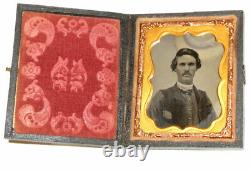
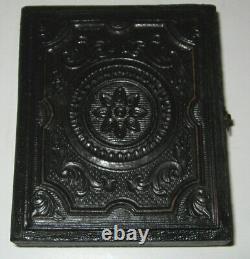
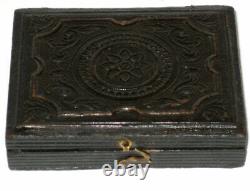
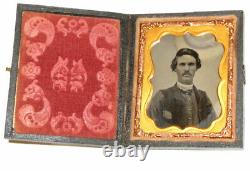
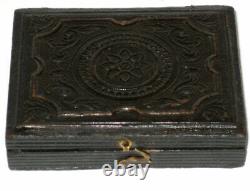
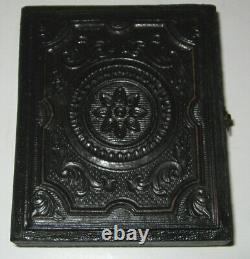
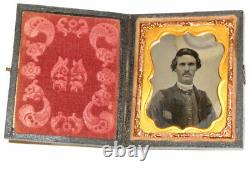
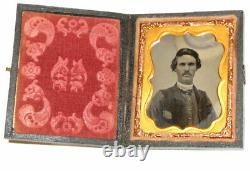


Original Tintype Photograph in Enclosed Velvet-Lined Picture case. Portrait of a gentleman, Civil War era. Encased within the original case / gilt frame. If there is any inaccuracy in this description it is due to my ignorance. This is in exceptionally well preserved condition, and is fully intact with only very light wear.
There appears to be a circular ring at the upper right of the tintype, which I assume is normal. I do not know whether this is a daguerreotype, tintype, or ambrotype. Decorative embossing on top and bottom of case. From the 19th century, date is unknown, presumably Civil War or post War era.
Hook clasp still fully intact. Embossed red cushion velvet opposite portrait for protection and presentation. Gilded frame border around tintype. Frame appears to be made out of wood with leather hinge.
Dimensions: 2 15/16 inches by 2 7/16 inches. Photograph and framing from the Civil War era.
A well preserved artifact from American history in remarkable condition. On the rear of the picture is an original George Washington 2 cents stamp. Even greater than my ignorance with Tintypes is my ignorance with stamps.
On the back of the picture is a hand-cancelled 5 cent Express revenue stamp, Scott R25c. The stamp should have had a Proprietary or Playing Card title, but the use of other titles is not that uncommon. TintypeFrom Wikipedia, the free encyclopediaJump to navigationJump to searchThis article needs additional citations for verification. Please help improve this article by adding citations to reliable sources.
Unsourced material may be challenged and removed. Find sources: "Tintype" news · newspapers · books · scholar · JSTOR (March 2015) (Learn how and when to remove this template message) Tintype of two girls in front of a painted background of the Cliff House and Seal Rocks in San Francisco, circa 1900.
A tintype , also known as a melainotype or ferrotype , is a photograph made by creating a direct positive on a thin sheet of metal coated with a dark lacquer or enamel and used as the support for the photographic emulsion. Tintypes enjoyed their widest use during the 1860s and 1870s, but lesser use of the medium persisted into the early 20th century and it has been revived as a novelty and fine art form in the 21st. Tintype portraits were at first usually made in a formal photographic studio, like daguerreotypes and other early types of photographs, but later they were most commonly made by photographers working in booths or the open air at fairs and carnivals, as well as by itinerant sidewalk photographers. Because the lacquered iron support (there is no actual tinused) was resilient and did not need drying, a tintype could be developed and fixed and handed to the customer only a few minutes after the picture had been taken.
The tintype photograph saw more uses and captured a wider variety of settings and subjects than any other photographic type. It was introduced while the daguerreotype was still popular, though its primary competition would have been the ambrotype. The tintype saw the Civil War come and go, documenting the individual soldier and horrific battle scenes. It captured scenes from the Wild West, as it was easy to produce by itinerant photographers working out of covered wagons.
It began losing artistic and commercial ground to higher quality albumen prints on paper in the mid-1860s, yet survived for well over another 40 years, living mostly as a carnival novelty. The tintype's immediate predecessor, the ambrotype, was done by the same process of using a sheet of glass as the support. The glass was either of a dark color or provided with a black backing so that, as with a tintype, the underexposed negative image in the emulsion appeared as a positive.
Tintypes were sturdy and did not require mounting in a protective hard case like ambrotypes and daguerreotypes. 2.1Ambrotype as a precursor. 2.2Success of the tintype. There are two historic tintype processes: wet and dry.In the wet process, a collodion emulsion containing suspended silver halide crystals had to be formed on the plate just before it was exposed in the camera while still wet. Chemical treatment then reduced the crystals to microscopic particles of metallic silver in proportion to the intensity and duration of their exposure to light, resulting in a visible image.
The later and more convenient dry process was similar but used a gelatin emulsion which could be applied to the plate long before use and exposed in the camera dry. In both processes, a very underexposed negative image was produced in the emulsion. Its densest areas, corresponding to the lightest parts of the subject, appeared gray by reflected light. The areas with the least amount of silver, corresponding to the darkest areas of the subject, were essentially transparent and appeared black when seen against the dark background provided by the lacquer.
The image as a whole therefore appeared to be a dull-toned positive. [2][page needed][3] This ability to employ underexposed images allowed shorter exposure times to be used, a great advantage in portraiture. To obtain as light-toned an image as possible, potassium cyanide was normally employed as the photographic fixer.
It was perhaps the most acutely hazardous of all the several highly toxic chemicals originally used in this and many other early photographic processes. One unusual piece of tintype equipment was a twelve-lensed camera that could make a dozen 34-by-1-inch (19 mm × 25 mm) "gem" portraits with one exposure, developed in 1858. [2] Portrait sizes ranged from gem-size to 11 in × 14 in (280 mm × 360 mm).
From about 1865 to 1910, the most popular size, called "Bon-ton", ranged from 2 38 in × 3 12 in (60 mm × 89 mm) to 4 in × 5 34 in (100 mm × 150 mm). Each tintype is usually a camera original, so the image is usually a mirror image, reversed left to right from reality. Sometimes the camera was fitted with a mirror or right-angle prism so that the end result would be right-reading. Tintype portrait in a paper mat, taken at Pease's Nantasket Tintype Gallery, circa 1900.The process was first described by Adolphe-Alexandre Martin in France in 1853. In 1856 it was patented by Hamilton Smith in the United States and by William Kloen in the United Kingdom. The ambrotype was the first use of the wet-plate collodion process as a positive image. Such collodion glass positives had been invented by Frederick Scott Archer in 1851 and the name Ambrotype was introduced in the United States by James Ambrose Cutting in 1854 when he patented a variation of Archer's original process. The tintype was essentially a variant of the ambrotype, replacing the latter's glass plate with a thin sheet of japannediron (hence ferro).
Ambrotypes often exhibit some flaking of their black back coating, cracking or detachment of the image-bearing emulsion layer, or other deterioration, but the image layer on a tintype has proven to be typically very durable. Compared to their most important predecessor, the daguerreotype, tintypes were not only very inexpensive, they were also relatively easy and quick to make. [3] A photographer could prepare, expose, develop and varnish a tintype plate and have it ready for the customer in a few minutes. Although early tintypes were sometimes mounted in protective ornamental cases, like daguerreotypes and ambrotypes, uncased tintypes in simple paper mats were popular from the beginning. They were often later transferred into the precut openings provided in book-like photograph albums.
One or more hardy, lightweight, thin tintypes could be carried conveniently in a jacket pocket. They became very popular in the United States during the American Civil War. Although prints on paper (see cartes de visite and cabinet cards) soon displaced them as the most common type of photograph, the tintype process continued to enjoy considerable use throughout the 19th century and beyond, especially for casual portraiture by novelty and street photographers.
Estabrooke's book The Ferrotype and How to Make It (1872), and the introduction of low cost variants known as "Gem ferrotypes" helped to sustain the tintype's longevity. A tintype attempt from 2018. John Coffer, as profiled in a 2006 New York Times article, travels by horse-drawn wagon creating tintypes. In 2013, California Air National Guard member and artist Ed Drew took the first tintypes in a war zone since the Civil War, when he photographed Air Force pilots serving in the Afghan War. The contemporary photographer Victoria Will created a series of tintypes of Hollywood stars at the 2014 and 2015 Sundance Film Festivals, including portraits of Anne Hathaway, Nick Cave, and Ewan McGregor.
[8] The portraits were later published as a book. Ferrotyping is a finishing treatment applied to glossy photographic paper to bring out its reflective properties. Newly processed, still-wet photographic prints and enlargements that have been made on glossy-type paper are squeegeed onto a polished metal plate called a ferrotyping plate. When they dry and split off due to slight shrinkage, they retain a highly reflective gloss. The item "1800's TINTYPE IN VELVET CASE!
Photograph Civil War Era Ambrotype Daguerreotype" is in sale since Friday, September 13, 2019. This item is in the category "Books & Magazines\Antiquarian & Collectible". The seller is "merchants-rare-books" and is located in Moab, Utah.
This item can be shipped worldwide.
- Binding: Fine Binding
- Language: English
- Special Attributes: Tintype
- Author: American
- Publisher: Tintype Photograph
- Topic: Civil War (1861-65)
- Country/Region of Manufacture: United States
- Modified Item: No
- Subject: History
- Original/Facsimile: Original

